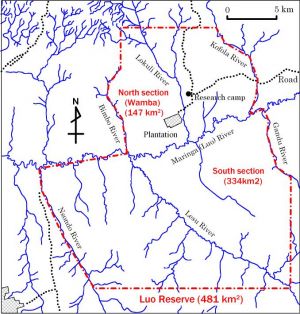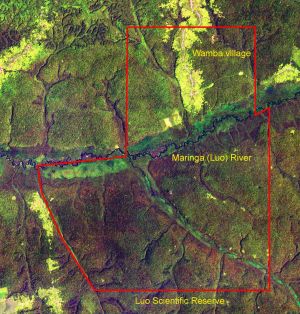Luo Scientific Reserve
Central Africa > Democratic Republic of the Congo > Luo Scientific Reserve
Français | Português | Español | Bahasa Indonesia | Melayu
Summary
- Bonobos (Pan paniscus) are present in Luo Scientific Reserve.
- It has been estimated that 173 to 231 individuals occur in the site.
- The bonobo population trend is decreasing.
- The site has a total size of 481 km².
- Key threats to bonobos are habitat encroachment as a result of agricultural expansion, and hunting, particularly during past periods of civil conflict .
- Conservation activities have focused on the maintenance of infrastructure, medical services, and education.
- Long-term studies on wild bonobos began at Wamba, Luo Scientific Reserve, in 1973.
Site characteristics
Table 1. Basic site information for Luo Scientific Reserve
| Species | 'Pan paniscus |
| Area | 481 km² |
| Coordinates | Lat: 0.045 , Lon: 22.543 |
| Type of site | Protected area (Multiple Sustainable Use Reserve) |
| Habitat types | Subtropical/tropical moist lowland forest, Subtropical/tropical swamp forest |
| Type of governance |
IUCN habitat categories Site designations
Ape status
The study of bonobos at Wamba (in the northern sector of the current Luo Scientific Reserve) started in 1973. The number of bonobos were steadily increasing until some cases of illegal hunting occurred in the 1980's. In order to protect bonobos in this area, a Congolese research center and Japanese researchers established a station for scientific research in 1992, which included both northern and southern sectors on both banks of the Luo River. During two periods of civil war, from 1996 to 2003, bonobos in the northern sector decreased to 40% and those in the southern sector disappeared from half of the area. Bonobos in the northern sector steadily increased from 2003 when research activities resumed, and almost recovered to the previous population size, but the current trend in the southern sector is unknown (Furuichi pers. comm. 2020).
Table 2. Ape population estimates reported for Luo Scientific Reserve
| Species | Year | Occurrence | Encounter or vistation rate (nests/km; ind/day) | Density estimate [ind./ km²] (95% CI) | Abundance estimate (95% CI) | Survey area | Sampling method | Analytical framework | Source | Comments | A.P.E.S. database ID |
|---|---|---|---|---|---|---|---|---|---|---|---|
| Pan paniscus | 1996 | 0.36 | 173 | Luo Scientific Reserve (481 km²) | Line transects | Hashimoto & Furuichi, 2001 | |||||
| Pan paniscus | 1996 | 0.48 | 231 | Luo Scientific Reserve (481 km²) | Full count | Hashimoto & Furuichi, 2001 | Density was estimated by number of individuals/ranging area for two study groups. |
Threats
Bonobos in the northern sector decreased to 40% between 1991 and 2002 probably due to hunting by soldiers and local people, but they steadily recovered after 2003 when research resumed. During the war, people who fled from the village made a number of small homesteads in the forest. Currently, local people are expanding their agricultural fields into the protected area (Furuichi pers. comm. 2020).
Table 3. Threats to apes reported for Luo Scientific Reserve
| Category | Specific threats | Threat level | Description | Year of threat |
|---|---|---|---|---|
| 1 Residential & commercial development | Absent | |||
| 3 Energy production & mining | Absent | |||
| 4 Transportation & service corridors | Absent | |||
| 6 Human intrusions & disturbance | Absent | |||
| 7 Natural system modifications | Absent | |||
| 9 Pollution | Absent | |||
| 10 Geological events | Absent | |||
| 12 Other threat | Absent | |||
| 2 Agriculture & aquaculture | 2.1 Annual & perennial non-timber crops | Medium (30-70% of population affected) | Agricultural expansion into the protected area (Furuichi pers. comm. 2020) | Ongoing (2020) |
| 5 Biological resource use | 5.1 Hunting & collecting terrestrial animals | Medium (30-70% of population affected) | Bonobos in the northern sector decreased to 40% between 1991 and 2002 during civil conflict due to hunting by soldiers and local people, but they steadily recovered after 2003 when we resumed the study (Furuichi pers. comm. 2020). | 1991-1996; 1996-2002 |
| 8 Invasive & other problematic species, genes & diseases | Unknown | |||
| 11 Climate change & severe weather | Unknown |
Conservation activities
In order to strengthen public awareness, an NGO called “Support for Conservation of Bonobos” was established to help in the maintenance of infrastructure, medical services, and education that had been seriously damaged by the war. A joint patrolling program involving people from all homesteads in Wamba village is also implemented (Furuichi pers. comm. 2020).
Table 4. Conservation activities reported for Luo Scientific Reserve
| Category | Specific activity | Description | Implementing organization(s) | Year of activity |
|---|---|---|---|---|
| 7 Economic & other incentives | 7.2 Provide non-monetary benefits to local communities for sustainably managing their forest and its wildlife (e.g., better education, infrastructure development) | Support for local community (maintenance of infrastructure, medical services, and education; Furuichi pers. comm. 2020) | Ongoing (2020) |
Conservation activities list (Junker et al. 2017)
Challenges
Table 5. Challenges reported for Luo Scientific Reserve
| Challenges | Specific challenges | Source | Year(s) |
|---|---|---|---|
| 6 Safety and stability | 6.3 Civil unrest/war | Nackoney et al, 2014; Idani et al, 2008 | |
| 3 Engaged community | 3.1 General lack of community engagement or support | Furuichi pers. comm. 2020 |
Enablers
Table 6. Enablers reported for Luo Scientific Reserve
| Enablers | Specific enablers | Source | Year(s) |
|---|---|---|---|
| 1 Site management | |||
| 2 Resources and capacity | |||
| 3 Engaged community | |||
| 4 Institutional support | |||
| 5 Ecological context | |||
| 6 Safety and stability |
Research activities
In the northern sector, behavioral and ecological studies of bonobos have been conducted since 1973, except for a break between 1992 and 2002 due to political instability and civil war. In the southern sector, an ecological survey was being conducted until 1992; currently no research activities are being carried out in this sector (Furuichi pers. comm. 2020).
Documented behaviours
Table 7. Behaviours documented for Luo Scientific Reserve
| Behavior | Source |
|---|---|
Exposure to climate change impacts
External links
Relevant datasets
References
Kano T (1992) The Last Ape: Pygmy Chimpanzee Behavior and Ecology. Stanford University Press, Stanford, California
Kano T, Bongoli L, Idani G, Hashimoto C (1996) The challenge of Wamba. Etica & Animali 8/96: 68-74
Hashimoto C, Furuichi T (2001) Current situation of bonobos in the Luo Reserve, Equateur, Democratic Republic of Congo. In: All apes great and small, vol.1: African Apes Kluwer Acad/Plenum, New York, pp 83-93
Idani G, Mwanza N, Ihobe H, Hashimoto C, Tashiro Y, Furuichi T (2008) Changes in the status of bonobos, their habitat, and the situation of humans at Wamba in the Luo Scientific Reserve, Democratic Republic of Congo. In: Furuichi T, Thompson J (eds) The bonobos: behavior, ecology, and conservation. Springer, New York, pp 291-302
Furuichi T et al. (2012) Long-term studies on wild bonobos at Wamba, Luo Scientific Reserve, D. R. Congo: towards the understanding of female life history in a male-philopatric species. In: Kappeler PM, Watts DP (eds) Long-term field studies of primates. Springer-Verlag, Berlin, Heidelberg, pp 413-433
Nackoney J, Molinario G, Potapov P, Turubanova S, Hansen MC, Furuichi T (2014) Impacts of civil conflict on primary forest habitat in northern Democratic Republic of the Congo, 1990–2010. Biol Conserv http://dx.doi.org/10.1016/j.biocon.2013.12.033
Page created by: Takeshi Furuichi Date: NA

